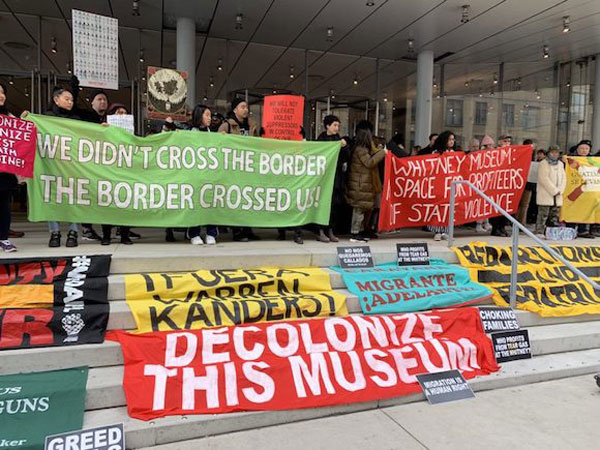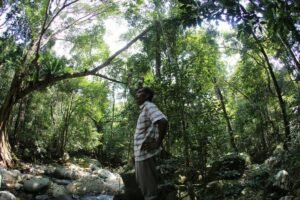
March 22, 2019; ArtNews
As we read this story, let’s keep in mind the idea that it is possible to curate spaces from places other than a position of power. Tonight, artists and activists with the group Decolonize This Place (DTP) will gather at the Whitney Museum for an evening of protest and “freedom songs.” It is the second of nine weeks of planned protest events at the museum; they started last week by holding signs and using an illuminator to project their message on the side of the museum.
Their message is that vice chairman Warren B. Kanders must be removed from the Whitney Museum’s board. Kanders owns and runs a company called Safariland that manufactures, among other things, tear gas canisters; it is Safariland’s canisters that (according to DTP) were used on protestors at the San Ysidro border crossing in California last November, as well as in Ferguson and Standing Rock.
As NPQ reported in December, 100 staff members at the Whitney signed a letter (which bears reading in full) to the museum’s leadership, explaining how state violence impacted their communities and that they were “sick to [their] stomachs” upon learning of the Whitney’s involvement with Safariland.
The letter criticized museum leadership’s silence on the matter, and by now both the museum and Kanders have responded.
Museum director Adam Weinberg’s letter cited the oft-quoted description of the Whitney as “a safe space for unsafe ideas.” He acknowledged the many crises afflicting the world at present but said, “The Whitney is first and foremost a museum. It cannot right all the ills of an unjust world, nor is that its role.” He acknowledged and celebrated the progressive work of the museum and the artists it showcases, and stated, “we each have our critical and complementary roles: trustees do not hire staff, select exhibitions, organize programs or make acquisitions, and staff does not appoint or remove board members.” Essentially, he called for civility and adherence to established rules; NPQ readers may want to read Cyndi Suarez on over-emphasized civility and the harm it does to communities of color.
Kanders himself wrote saying he was proud of his company, stressing his adherence to government licensing and approval regulations in the sale of tear gas and other products. “The staff letter implies that I am responsible for the decision to use these products,” he wrote. “I am not…I think it is clear that I am not the problem the authors of the letter seek to solve.”
In defense of his personal values, Kanders expressed the hope that his philanthropic involvement with the Whitney and other public programs on art and activism “speaks for itself.”
Sign up for our free newsletters
Subscribe to NPQ's newsletters to have our top stories delivered directly to your inbox.
By signing up, you agree to our privacy policy and terms of use, and to receive messages from NPQ and our partners.
DTP and others have not accepted either Weinberg’s or Kanders’ arguments. They have shown up with signs saying, “Safariland Supplies the NYPD,” “Brought To You By Safariland,” “What’s Good, Whitney?” and “Warren Kanders must go!” In a statement, DTP wrote,
Museum director Adam Weinberg issued a response in which he essentially told the concerned staff to know their place, do their jobs, and stay in line. We commend the efforts of the Whitney staff, and recognize the courage displayed and the risk they have taken in organizing and speaking out…the entire institution of the Whitney faces a broad crisis of legitimacy.
Elsewhere, they have said, “Warren Kanders is just the start of the crisis at the Whitney. There is no safe space for profiteers of state violence.”
DTP is attempting to pressure the museum leadership without making life more difficult for the staff; they distributed fliers saying, “We understand that we may cause some inconvenience for you and we apologize for any stress or added work, but know that we are in solidarity and our struggles are connected.” One worker reportedly told DTP, “If we weren’t working, we’d be protesting with you.”
Artist Shellyne Rodriguez, a DTP collaborator, said, “We are doing our best today to not cause problems for the staff, but we want to cause problems for Adam Weinberg and his homey Warren Kanders.”
Others have joined the DTP protests, including artist Michael Rakowitz, who withdrew from the Whitney Biennial, saying that he viewed the photographs from the San Ysidro border as a visualization of “toxic philanthropy.” He told the New York Times’ Jillian Steinhauer, “You should not compromise the integrity of an artist and ask them to show with funding and permission from people that make conditions unsafe for others.”
DTP intends their events to grow from week to week to provoke a response from the museum.—Erin Rubin











